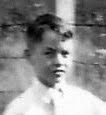There is a small chapel on Portland known locally as the avalanche church. It got its name following a collision between two ships – the “Avalanche” and the “Forest” on a stormy night in 1877. Both ships sunk with a huge loss of life – many young families were passengers on the Avalanche. Just twelve souls were rescued by local boatmen and enough money was raised afterwards to build this chapel in memory of the dead.
The anchor in the churchyard is from the Avalanche and the stained glass windows in the church depict streams of bubbles – large bubbles for drowned adults and small bubbles for the children.
They have pollarded the trees outside the caravan allowing us a free view to the top of Jordan Hill. One particular pigeon has adopted this newly formed platform as his favourite perch. I snapped him as he looked distinctly puzzled at the strange bird close by.
And while Mr.Pidge wasn't looking, a handsome green woodpecker - or "yaffle" - nicked his spot.
For many years there has been a tradition of sand sculpture on Weymouth beach and now, a new and permanent sand sculpture exhibition has opened near the sea life centre. Artists from round the world were invited to do their stuff and here is a simple of their work.
We discovered a place a few days ago that even most local people have never heard of. Wolfeton House, just outside Dorchester is a gem. Dating from the thirteen hundreds this lovely old house at the end of a rutted track running through water meadows is home to Captain & Mrs Thimbleby. We were shown around the ancient rooms by the captain and his elderly lady guide. Nothing has been “tarted up” in this atmospheric building; dust and cobwebs just add to the charm and the private areas of the rooms are cordoned of with binder twine looped over chair backs. I spent much of the visit talking with Nigel Thimbleby, a charming man, and he proudly showed us the results of his refurbishment work. This simply meant ripping out “improvements” in order to reveal the original fabric. If you ever visit, the recently revealed original oak floor in the great hall is a show stopper.
In 1594 the left hand tower of the gatehouse pictured above was used to imprison a catholic priest named Cornelius. He refused to renounce his faith and was taken to Dorchester, tried and hung, drawn and quartered. He haunts the stairs that lead up to his cell. I don’t blame him, it probably hurt like hell!
Subscribe to:
Post Comments (Atom)

No comments:
Post a Comment